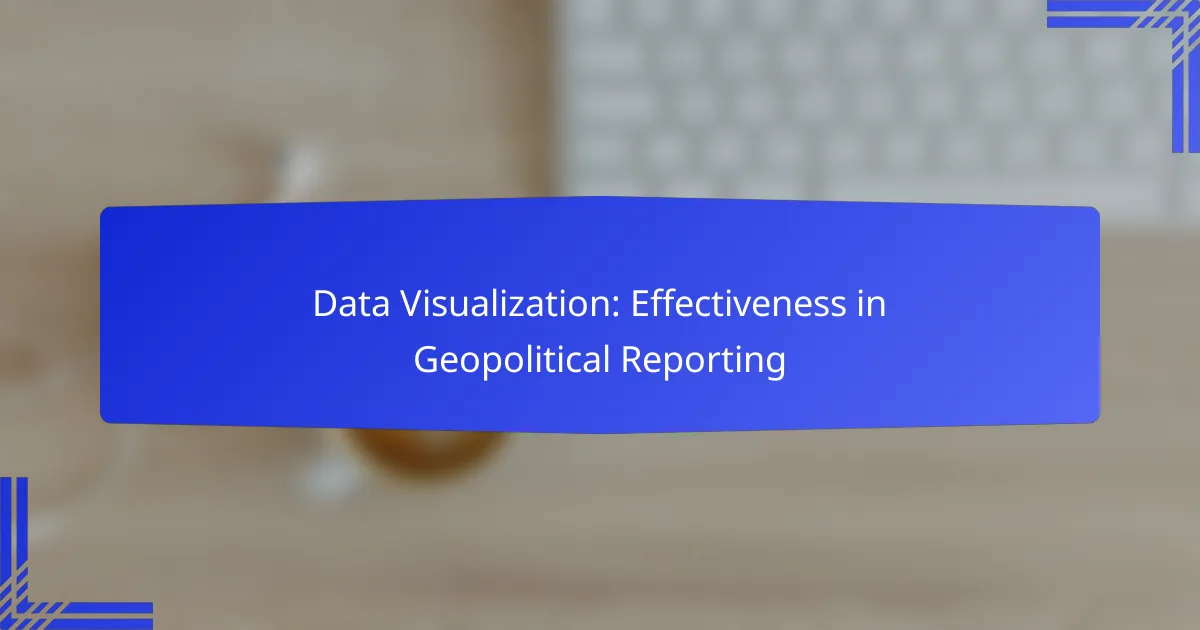Data visualization plays a crucial role in geopolitical reporting by converting complex information into clear visual formats, which enhances audience comprehension of intricate global issues. By utilizing effective tools like Tableau and ArcGIS, analysts can present data in engaging ways that promote informed discussions and decision-making.
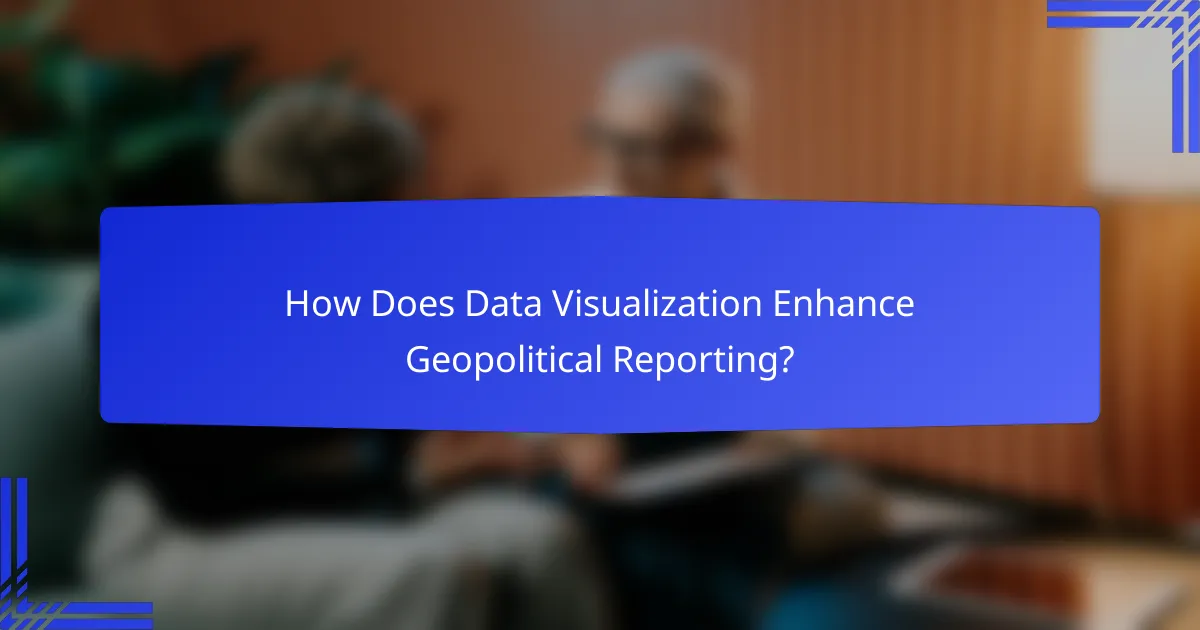
How Does Data Visualization Enhance Geopolitical Reporting?
Data visualization enhances geopolitical reporting by transforming complex data into accessible visual formats, making it easier for audiences to grasp intricate global issues. By presenting information visually, it fosters understanding and engagement, allowing for more informed discussions and decisions.
Improves clarity and comprehension
Data visualization improves clarity by simplifying complex information into digestible formats like charts, maps, and graphs. For instance, a heat map can illustrate conflict zones, making it easier for viewers to understand the geographical distribution of tensions.
Visual elements highlight key trends and relationships that might be overlooked in textual data. This clarity helps journalists convey nuanced geopolitical dynamics, ensuring that audiences can quickly grasp essential points without getting lost in jargon or dense statistics.
Facilitates quick insights
Visual representations allow for rapid insights, enabling viewers to identify patterns and anomalies at a glance. For example, a line graph showing economic indicators over time can quickly reveal trends in a country’s economic health, aiding in timely reporting.
Using color coding and interactive elements can further enhance this speed of understanding. Audiences can filter data to focus on specific regions or time frames, making it easier to draw conclusions swiftly in fast-paced news environments.
Supports data-driven narratives
Data visualization supports data-driven narratives by providing a compelling backdrop for storytelling. By integrating visuals with textual analysis, journalists can create a more persuasive argument, backed by empirical evidence.
For example, combining a bar chart of military expenditures with a narrative on defense strategies can illustrate the relationship between spending and geopolitical posture. This approach not only informs but also engages the audience, making the reporting more impactful.
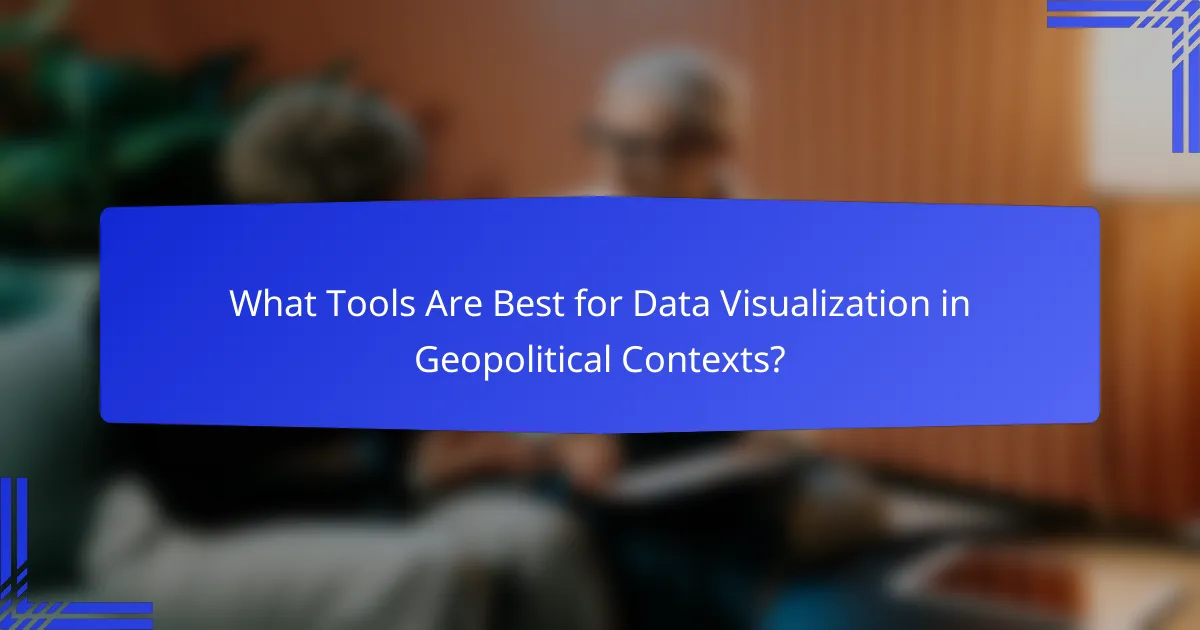
What Tools Are Best for Data Visualization in Geopolitical Contexts?
Effective data visualization tools for geopolitical contexts include Tableau, ArcGIS, and Power BI. Each tool offers unique features that cater to different aspects of data analysis, from interactive dashboards to advanced mapping capabilities.
Tableau for interactive dashboards
Tableau is renowned for its ability to create interactive dashboards that allow users to explore data dynamically. It supports a variety of data sources and offers drag-and-drop functionality, making it accessible for users with varying levels of technical expertise.
When using Tableau for geopolitical reporting, consider integrating real-time data feeds to enhance the relevance of your visualizations. This can help in tracking ongoing events and trends, providing a clearer picture of geopolitical shifts.
ArcGIS for mapping
ArcGIS specializes in geographic information systems (GIS), making it ideal for mapping and spatial analysis in geopolitical contexts. It allows users to visualize complex data sets on maps, which can highlight regional trends and relationships effectively.
For best results, leverage ArcGIS’s extensive library of basemaps and spatial analysis tools. This can help in visualizing demographic data, resource distribution, and conflict zones, providing deeper insights into geopolitical issues.
Power BI for business intelligence
Power BI is a powerful tool for business intelligence that can also be applied to geopolitical data visualization. It offers robust data modeling capabilities and integrates seamlessly with other Microsoft products, making it a convenient choice for organizations already using Microsoft services.
To maximize Power BI’s effectiveness, focus on creating clear, concise reports that highlight key metrics and trends. Use its sharing features to disseminate insights across teams, ensuring that decision-makers have access to relevant geopolitical data.
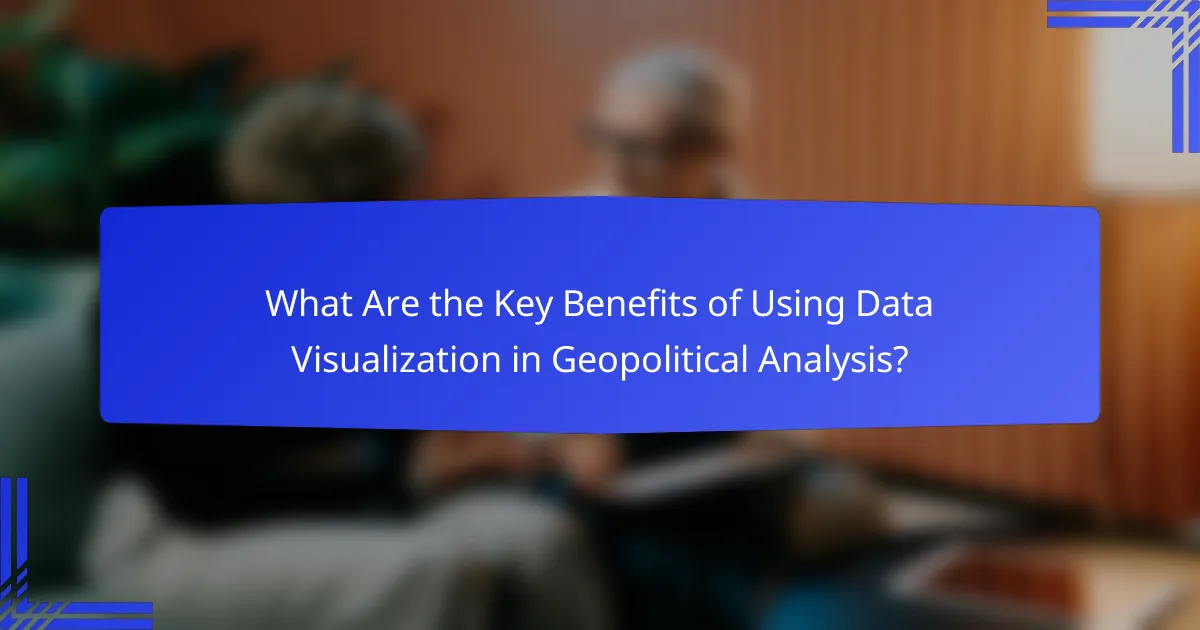
What Are the Key Benefits of Using Data Visualization in Geopolitical Analysis?
Data visualization enhances geopolitical analysis by transforming complex data into clear, visual formats that facilitate understanding and communication. This approach allows analysts and decision-makers to quickly grasp trends, patterns, and relationships within the data, leading to more informed insights.
Enhanced engagement with audiences
Visual representations of data capture attention more effectively than text-heavy reports. By utilizing charts, maps, and infographics, analysts can present information in a way that resonates with diverse audiences, from policymakers to the general public.
For example, a well-designed map highlighting conflict zones can convey urgency and significance, prompting quicker responses from stakeholders. Engaging visuals can also encourage discussions and foster a deeper understanding of geopolitical issues.
Better decision-making support
Data visualization aids decision-making by providing clear insights into complex geopolitical scenarios. Visual tools allow decision-makers to compare various data points, such as economic indicators or military deployments, facilitating a more comprehensive analysis of potential outcomes.
For instance, using a dashboard that displays real-time data on troop movements alongside historical trends can help military strategists make timely and informed decisions. This immediate access to visualized data can significantly enhance strategic planning and operational effectiveness.
Increased accessibility of complex data
Complex geopolitical data can be difficult to interpret without proper context. Data visualization simplifies this process by breaking down intricate datasets into digestible visuals that are easier to understand for non-experts.
Tools like interactive graphs and animated timelines can help users explore data at their own pace, making it more accessible. This democratization of information ensures that a wider audience can engage with and understand critical geopolitical issues, regardless of their background or expertise.
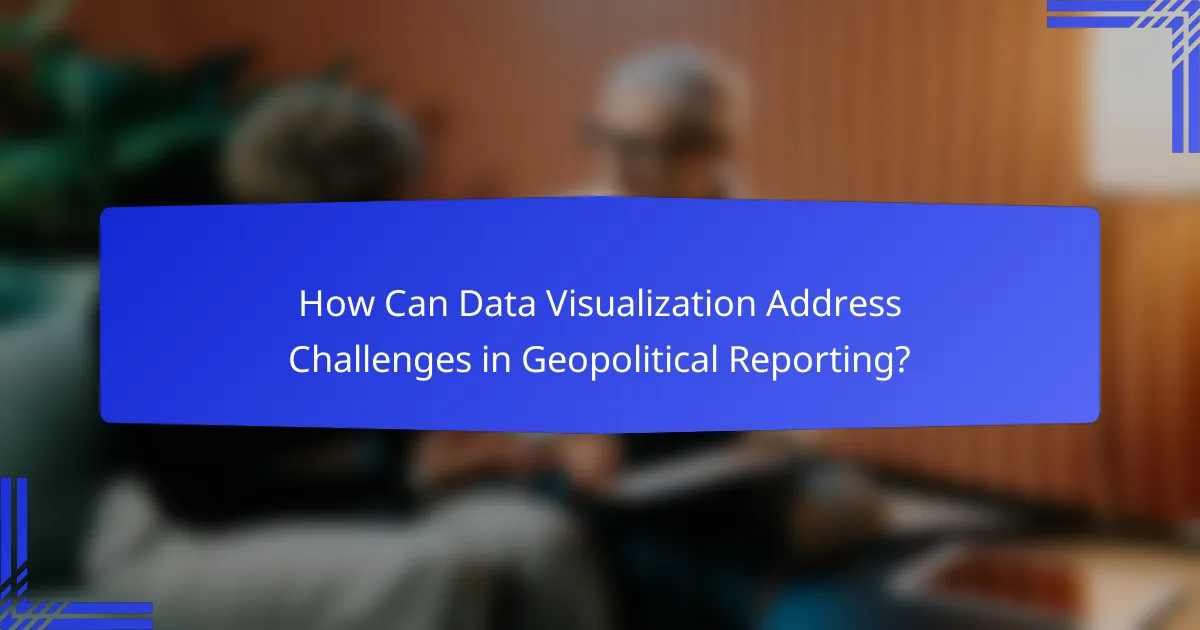
How Can Data Visualization Address Challenges in Geopolitical Reporting?
Data visualization can effectively tackle challenges in geopolitical reporting by transforming complex datasets into clear, digestible graphics. This approach enhances comprehension and facilitates quicker decision-making for analysts and the public alike.
Overcoming information overload
Geopolitical reporting often involves vast amounts of data, making it difficult for audiences to extract meaningful insights. Data visualization simplifies this process by highlighting key trends and relationships through charts, maps, and infographics. For instance, a heat map can effectively show conflict zones, allowing viewers to grasp the situation at a glance.
To combat information overload, focus on clarity and relevance in your visuals. Use simple designs that emphasize essential data points, and avoid cluttering graphics with excessive information. A good rule of thumb is to limit the number of variables displayed in a single visualization to ensure the message remains clear.
Visualizing uncertainty and risk
In geopolitical contexts, uncertainty and risk are inherent, and data visualization can help communicate these factors effectively. By employing techniques such as error bars or confidence intervals in graphs, analysts can illustrate the range of possible outcomes, providing a clearer picture of potential risks. For example, a line graph showing projected economic impacts can include shaded areas to represent uncertainty.
When visualizing uncertainty, it’s crucial to use consistent scales and clear legends to avoid misinterpretation. Additionally, consider incorporating interactive elements, such as sliders or dropdowns, that allow users to explore different scenarios and their associated risks. This engagement can enhance understanding and foster informed discussions among stakeholders.
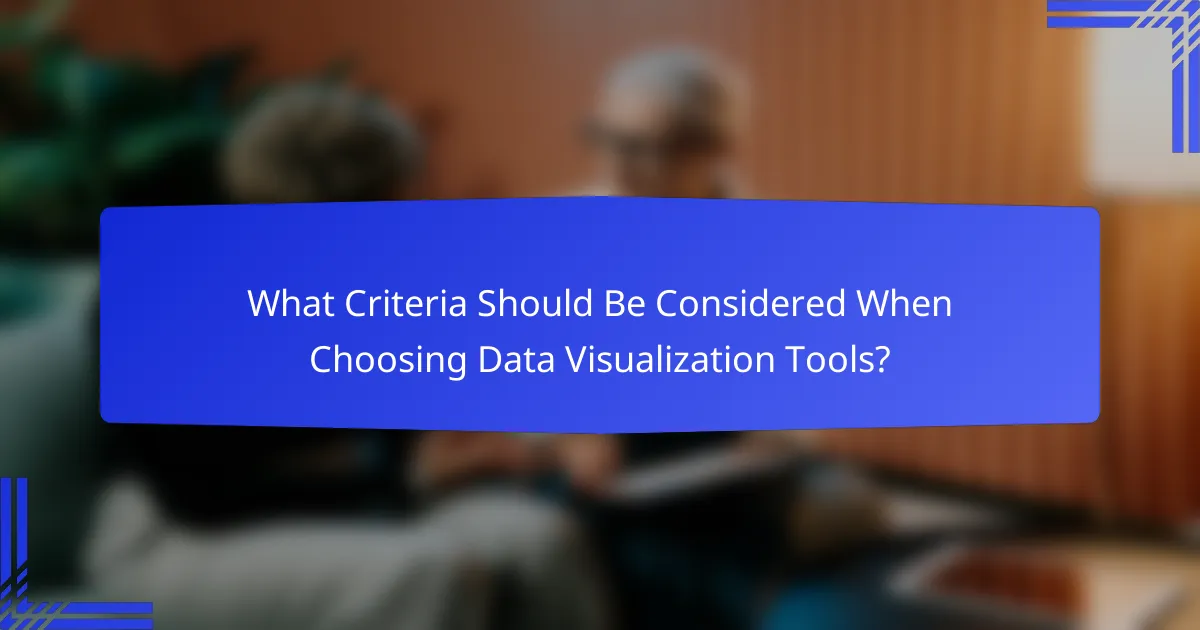
What Criteria Should Be Considered When Choosing Data Visualization Tools?
When selecting data visualization tools, consider user-friendliness, integration capabilities, and the specific needs of your geopolitical reporting. These factors will ensure that the tools effectively convey complex information in an accessible manner.
User-friendliness and learning curve
User-friendliness is crucial for ensuring that team members can quickly adopt and utilize the data visualization tools. A tool with an intuitive interface and straightforward functionalities will minimize the learning curve, allowing users to focus on analysis rather than technical challenges.
Look for tools that offer templates and drag-and-drop features, which can significantly enhance ease of use. Popular options like Tableau or Google Data Studio provide user-friendly environments that cater to both beginners and advanced users.
Integration with existing data sources
Integration capabilities are essential for seamless data flow between your visualization tools and existing data sources. Ensure that the tools can connect with databases, spreadsheets, and APIs that you currently use, as this will streamline the reporting process.
Consider tools that support popular data formats and platforms, such as CSV, SQL databases, or cloud services like AWS and Google Cloud. This compatibility will save time and reduce errors in data handling, making your geopolitical reporting more efficient.
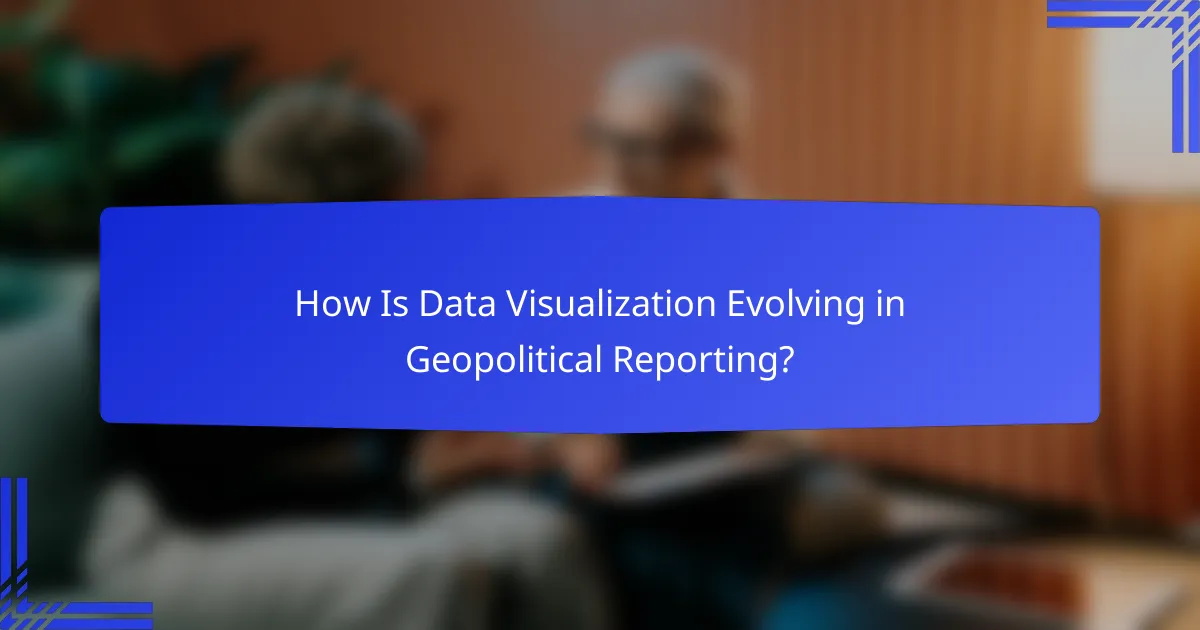
How Is Data Visualization Evolving in Geopolitical Reporting?
Data visualization is increasingly becoming a crucial tool in geopolitical reporting, enhancing the clarity and impact of complex information. By transforming raw data into visual formats, journalists can better convey trends, relationships, and insights that are vital for understanding global events.
Adoption of AI-driven analytics
The integration of AI-driven analytics in data visualization allows for more sophisticated analysis of geopolitical data. These tools can identify patterns and anomalies in large datasets, providing reporters with deeper insights that may not be immediately apparent through traditional methods.
For example, AI can analyze social media sentiment or economic indicators to predict political shifts. This capability enables journalists to create more informed narratives and visualizations, helping audiences grasp the implications of data-driven findings.
Increased use of real-time data
Real-time data is becoming essential in geopolitical reporting, allowing journalists to present the most current information available. This immediacy helps in visualizing ongoing events, such as conflicts or elections, where conditions can change rapidly.
Utilizing platforms that aggregate real-time data, such as news feeds or social media updates, can enhance the relevance of visualizations. However, it is crucial to verify the accuracy of this data to avoid misinformation, which can undermine credibility.
